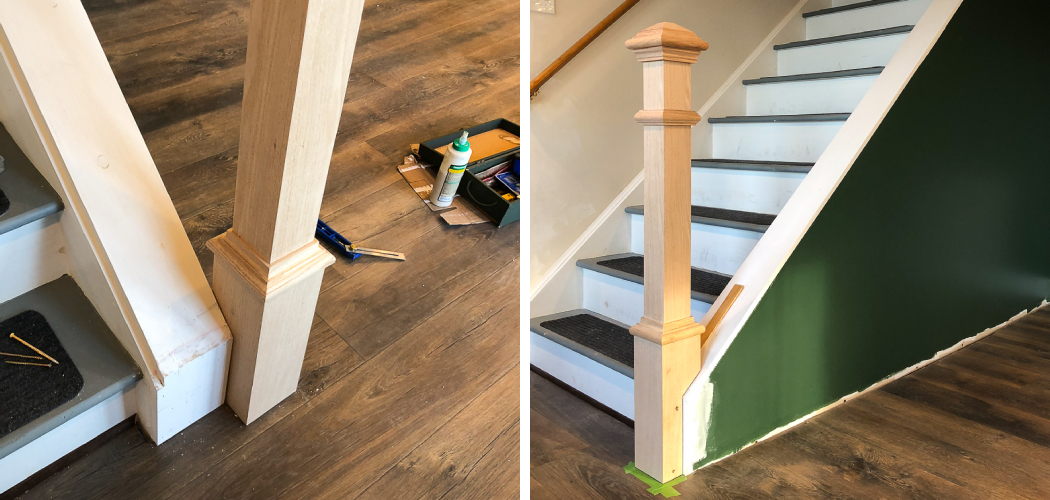Securing a newel post to the floor is a critical step in ensuring the stability and safety of a staircase. The newel post, a central and often decorative element of a staircase railing, requires a secure attachment to the floor to withstand the daily stresses of use. In this comprehensive guide, we will explore effective methods on how to secure newel post to floor. Whether you are installing a new post or reinforcing an existing one, understanding the proper techniques for securing it to the floor is essential.
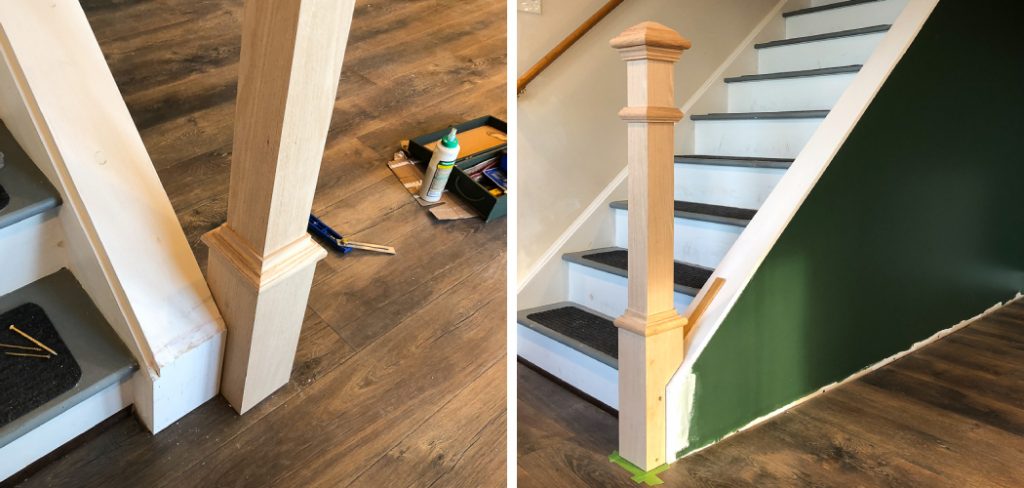
From selecting appropriate hardware to ensuring a level and sturdy installation, this guide is designed to empower homeowners and DIY enthusiasts with the knowledge necessary to create a durable and aesthetically pleasing staircase structure. Let’s delve into the intricacies of securing a newel post to the floor for a staircase that combines both form and function seamlessly.
What are Newel Posts?
Newel posts are the substantial, vertical pillars that anchor the ends or intersections of a staircase’s handrail system. Positioned at critical structural points along the staircase, these posts provide foundational support for the balusters and the handrail, forming an integral part of the staircase’s overall architecture.
Not merely functional, newel posts often serve as key design elements, with styles ranging from simple and streamlined to ornately carved, reflecting the architectural character of the home. Whether crafted from wood, metal, or another durable material, newel posts play a pivotal role in the safety, stability, and aesthetic appeal of staircase designs.
Functions of Newel Posts
Newel posts, beyond their structural contributions, fulfill several functions within a staircase design. Primarily, they are key to ensuring the integrity and safety of a staircase, serving as the main support for the handrail system. This is critical in preventing the handrail from wobbling or collapsing under weight or pressure. Additionally, newel posts also serve an aesthetic function. They offer a visual anchor and can be a focal point in staircase design, contributing significantly to the staircase’s overall style and the home’s interior decor.
Whether blending seamlessly with the home’s architectural style or standing out as a statement piece, newel posts can dramatically enhance the visual appeal of a space. Furthermore, in multifunctional spaces, newel posts can also serve as a base for decorative elements like lighting fixtures or plant holders, adding to the versatility and functionality of the staircase area.
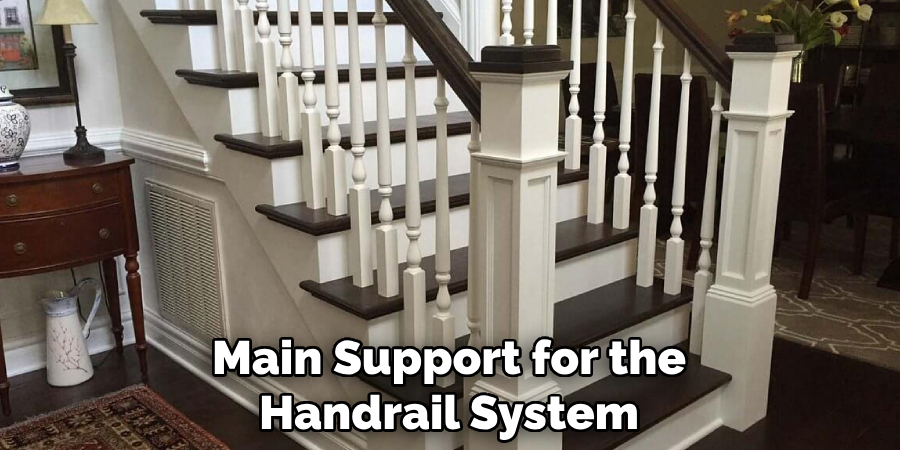
Structural Significance of Newel Posts
The structural significance of newel posts within a staircase cannot be overstated. They are not just decorative elements but are fundamentally crucial to the stability and safety of the staircase structure. Serving as the main anchor points for the handrail system, newel posts bear a significant portion of the load, especially in high-traffic areas where the handrails are often leaned on or grabbed for support.
This load-bearing capability is essential for preventing the handrail system from becoming loose or failing. In cases of spiral or winding staircases, the central newel post may carry an even greater load, providing the critical support needed to maintain the staircase’s integrity over time. The precise installation and secure fastening of newel posts are key to ensuring the long-term durability and safety of the staircase, making them an indispensable element in both the design and functionality of staircases in homes and buildings alike.
Different Types and Styles of Newel Posts
Newel posts come in a diverse array of types and styles, enabling them to complement a wide range of architectural and interior design themes. The choice of newel post can significantly influence the overall aesthetic and character of a staircase, making it essential to select a style that aligns with the desired look and feel of the space.
Box Newel Posts
Box newel posts are characterized by their solid, rectangular shape, offering a classic and sturdy appearance. Often made of wood, these posts can feature intricate carvings, moldings, or paneled sides, adding depth and detail to the stairway. Box newel posts are a popular choice in traditional or craftsman-style homes, where their substantial presence enhances the architectural detail of the space.

Turned Newel Posts
Turned newel posts are crafted using a lathe, resulting in a cylindrical shape with various designs carved into the post. These can range from simple, smooth patterns to elaborate spirals and flutes. Turned newel posts are suited to a variety of decor styles, from Victorian elegance to contemporary minimalism, depending on the complexity and design of the turning.
Metal Newel Posts
For a more modern or industrial look, metal newel posts are an excellent option. Constructed from materials such as wrought iron, steel, or aluminum, metal newel posts can come in simple, sleek designs or more ornate patterns incorporating scrolls or geometric shapes. Metal posts can also be combined with wood or glass for a mixed-materials effect that is both striking and contemporary.
Caps and Finials
The top of newel posts can be finished with caps or finials, adding an extra touch of style and sophistication. Caps are typically flat or slightly domed pieces that sit atop the post, while finials are more decorative, sculptural elements that can take the shape of spheres, acorns, or other artistic designs. The choice of cap or finial can significantly influence the final look of the newel post and, by extension, the staircase and surrounding space.
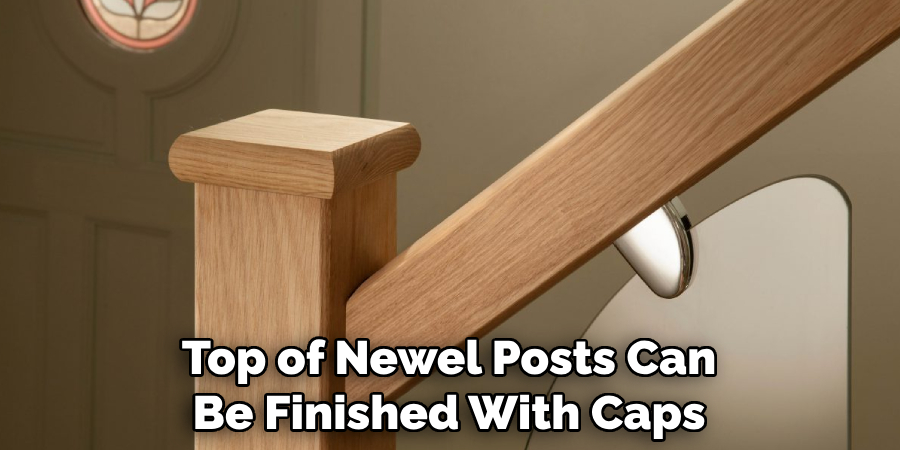
Each type and style of newel post offers a unique set of aesthetic and functional benefits, making it possible to find the perfect match for any staircase project. Whether the goal is to achieve a specific architectural style, complement the interior decor, or simply ensure structural integrity, there is a newel post design suited to meet those needs.
10 Methods How to Secure Newel Post to Floor
1. Choose the Right Newel Post:
Begin by selecting a newel post that suits the design and structural requirements of your staircase. Ensure it is made from a durable material such as wood or metal, and consider its height and style in relation to the railing. A taller post may be needed for a longer staircase, while a more intricately designed post can add visual interest to the overall look. If you are unsure, consult with a professional for guidance.
2. Locate the Ideal Position:
Carefully determine the optimal location for the newel post. It should provide adequate support and be visually aligned with the overall design of the staircase. Mark the floor where the center of the post will be placed. A good rule of thumb is to keep the post no more than 4 inches away from the edge of the stair tread. Additionally, it should be located at least 1 inch away from any wall or obstruction.
Selecting the best position for a newel post can greatly impact both the stability and aesthetic appeal of your staircase. It is important to consider both functional and design factors when determining its placement.
One key factor to consider is adequate support. The newel post should be positioned in a way that provides enough support for the handrail and balustrades. This will ensure the safety and stability of the staircase, especially if it is frequently used or has heavy foot traffic.
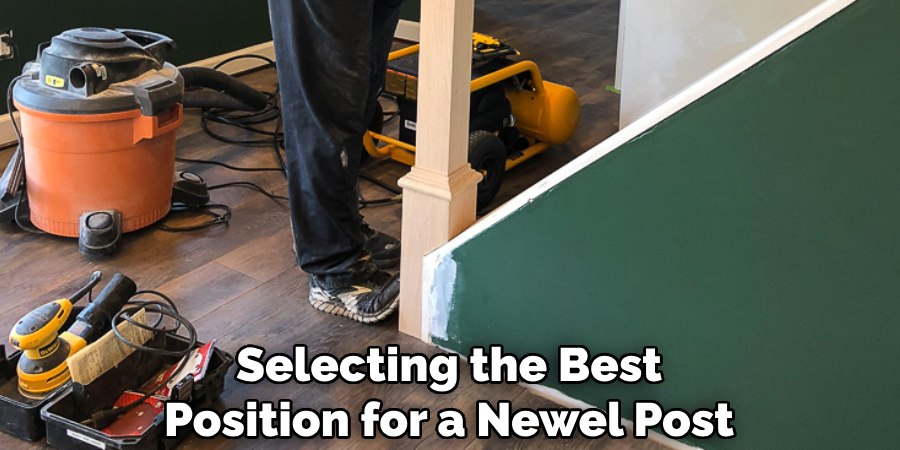
3. Prepare the Floor Surface:
Before securing the newel post, make sure the floor surface is clean and level. Remove any debris or irregularities, as they can affect the stability of the installation. A level surface ensures a secure and uniform attachment. This is especially important for hardwood or tile floors, as they may have slight variations that can cause the newel post to be uneven.
To ensure the floor surface is level, use a carpenter’s level and check in multiple directions. If there are any low spots, use a filler material to even out the surface. Allow the filler to dry completely before proceeding with the installation.
Once the floor surface is clean and level, mark the desired location for the newel post. It’s important to consider the overall design and placement of the staircase when determining where to install the newel post. The newel post should be placed in a visually appealing and structurally sound location.
4. Drill Pilot Holes:
To prevent splitting and ensure accurate placement, drill pilot holes into the marked position on the floor. The size of the pilot holes should match the size of the screws or bolts you will be using to secure the newel post.
After drilling the pilot holes, use a hammer to lightly tap in the screws or bolts. This will help ensure they are securely in place before fully tightening them with a drill or screwdriver.
It is important to note that pilot holes are not necessary for all types of newel posts. Some come with pre-drilled holes for easy installation. However, if your newel post does not have pre-drilled holes, it is highly recommended to use pilot holes for a more secure and accurate installation.
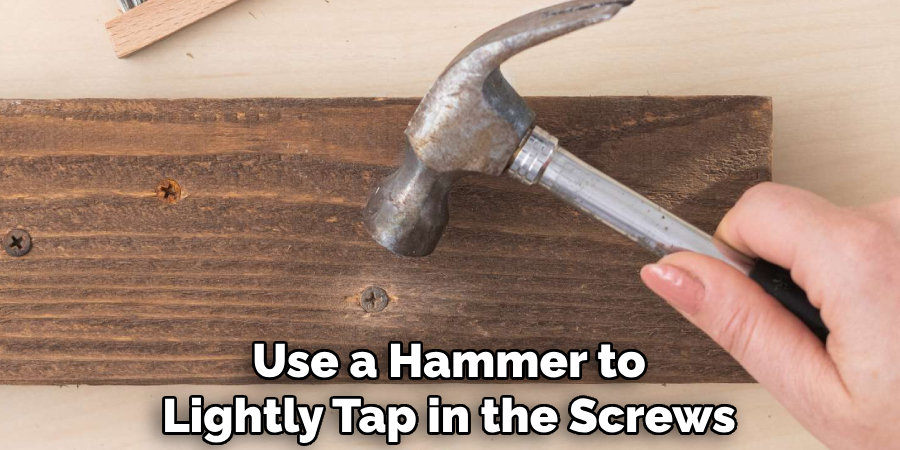
In addition to preventing splitting and ensuring accurate placement, pilot holes also help in reducing the risk of damaging the screws or bolts. Without pilot holes, the force required to insert the screws or bolts can potentially cause them to break or strip, making them unusable.
5. Insert Anchor Bolts or Screws:
Depending on the material of your floor (wood, concrete, or other), choose appropriate anchor bolts or screws. Insert them into the pilot holes and tighten them securely to the floor. Anchor bolts are particularly suitable for concrete surfaces. If you are unsure about the appropriate type of anchor bolts or screws, consult a professional or the product instructions.
In addition to anchor bolts and screws, there are other types of fasteners that can be used for attaching objects to floors. These include wedge anchors, toggle bolts, and plastic anchors. Each type has its own advantages and uses, so it is important to research and choose the best option for your specific project.
Regardless of the type of fastener you choose, it is important to always follow the manufacturer’s instructions and make sure they are securely attached to the floor. This will ensure that your objects are properly anchored and will not come loose over time.
6. Use Construction Adhesive:
Apply construction adhesive to the base of the newel post before securing it to the floor. This additional step provides extra bonding strength and helps stabilize the post. Follow the adhesive manufacturer’s instructions for proper application.
Construction adhesive is a strong, waterproof adhesive that is commonly used in construction projects. It can be used to bond a variety of materials together, including wood, metal, and stone. In the case of securing newel posts, construction adhesive is particularly useful as it helps to create a more stable and durable connection between the post and the floor.
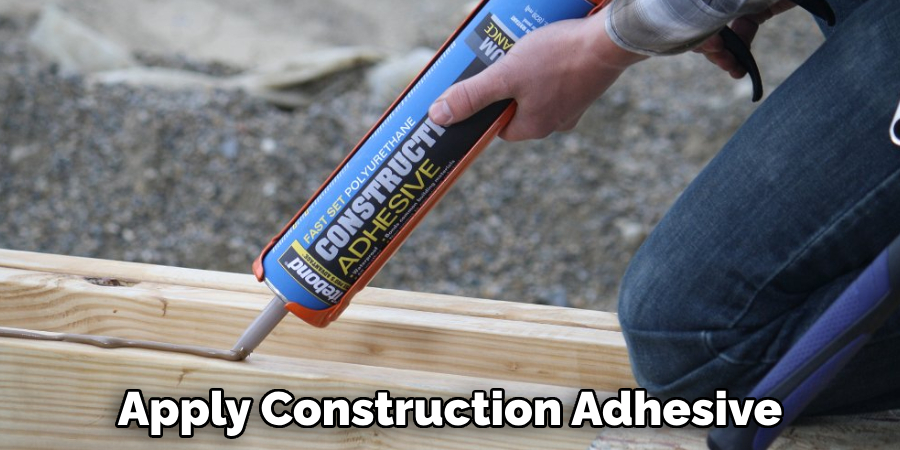
When applying construction adhesive to the base of the newel post, make sure to apply a generous amount and spread it evenly using a putty knife or spatula. This will ensure that the entire surface is covered and provide maximum bonding strength.
7. Install Blocking or Braces:
For added support, especially in the case of longer newel posts or those supporting heavy railings, consider installing blocking or braces beneath the floor. This structural reinforcement ensures enhanced stability.
Structural reinforcement is important for maintaining the stability of your staircase, especially if you have longer newel posts or heavy railings. In addition to using sturdy materials and proper construction techniques, it’s also helpful to install blocking or braces beneath the floor for added support.
Blocking refers to short pieces of wood that are inserted between joists or studs in order to provide extra strength and stability. Braces, on the other hand, are longer pieces of wood that run horizontally between joists or studs to provide support against lateral movement.
8. Utilize a Newel Post Fastener Kit:
Newel post fastener kits are available and include all the necessary components for a secure installation. These kits typically consist of screws, bolts, and brackets designed specifically for attaching a newel post to the floor. They come in a variety of styles and finishes to match any staircase design.
One of the benefits of using a newel post fastener kit is its convenience. Instead of having to purchase each individual component separately, all the necessary hardware is included in one package. This saves time and ensures that you have all the correct pieces for installation.
Another advantage of using a newel post fastener kit is its sturdiness. These kits are designed to withstand the weight and pressure of a newel post, ensuring it remains securely in place. This is especially important for high traffic areas such as staircases.
9. Secure with Lag Bolts:
Lag bolts are sturdy and reliable fasteners suitable for securing newel posts. Drill pilot holes, insert the lag bolts, and tighten them with a wrench to ensure a robust connection between the post and the floor. This will help prevent the post from becoming loose or wobbly, maintaining the safety and stability of your staircase.
To further secure the newel posts, you can also use construction adhesive. Apply a generous amount to the bottom of the post before attaching it with lag bolts. This will create an even stronger bond between the post and the floor, providing additional support and stability.
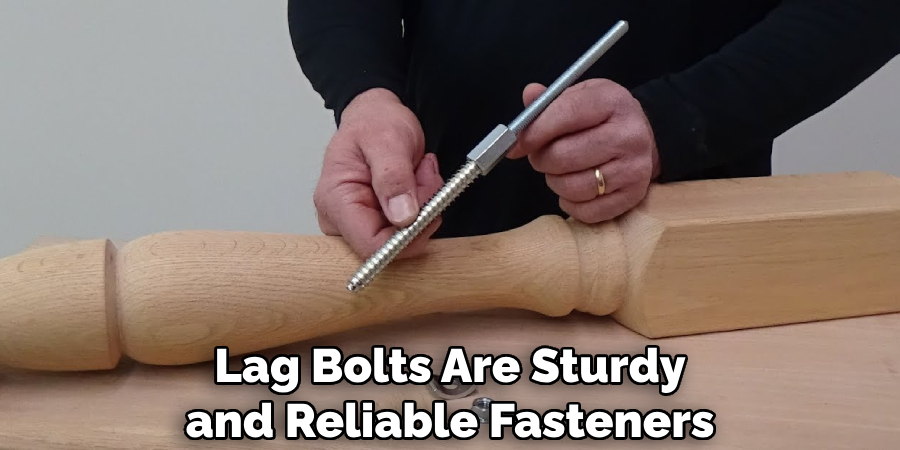
The combination of lag bolts and construction adhesive will ensure that your newel posts remain securely in place for years to come. Regularly check the bolts and tighten them if necessary to maintain the stability of your staircase.
10. Check for Stability:
Once the newel post is secured, check its stability by applying gentle pressure in different directions. Ensure there is no wobbling or movement. Make any necessary adjustments or further tightening to guarantee a solid and secure installation.
Checking for stability is a crucial step in the process of installing a newel post. A stable newel post will not only prevent accidents and injuries, but it will also ensure that the entire staircase structure remains intact for years to come.
To check for stability, start by applying gentle pressure in different directions. This will help you identify any potential weak spots or areas where the post may be wobbling or moving. If you notice any movement, it is important to make necessary adjustments and further tighten the post to ensure a solid installation.
Conclusion
In conclusion, securely fastening a newel post to the floor is crucial for ensuring the stability and safety of staircase structures. By understanding the components and proper installation techniques outlined, homeowners can confidently undertake this essential task. Through careful alignment, drilling pilot holes, and using appropriate fasteners like screws or anchor bolts, newel posts can be firmly anchored to the floor, providing reliable support for staircase railings and balustrades.
Additionally, considering reinforcement options and adhering to local building codes further enhances the structural integrity of the newel post installation. Regular maintenance and inspections are also key to identifying any potential issues early on and addressing them promptly. Hopefully, this article gave you some helpful tips about how to secure newel post to floor successfully, so now that you have the proper knowledge on how to get the job done, why not give it a try today?
